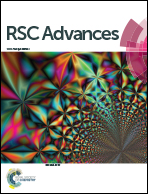Esterification of oleic acid in [Bmim]BF4/[Hmim]HSO4 + TX-100/cyclohexane ionic liquid microemulsion†
Abstract
Esterification of oleic acid was carried out in a 1-butyl-3-methylimidazolium tetrafluoroborate ([Bmim]BF4)/Triton X-100 + 1-hexyl-3-methylimidazolium hydrogen sulfate ([Hmim]HSO4)/cyclohexane microemulsion. A pseudo ternary phase diagram of the designed systems was drawn to investigate the phase behavior of the microemulsion, with the surfactant [Hmim]HSO4 acting as a catalyst. The effects of various reaction parameters were explored. The results showed that the maximum yield of lauryl oleate reaches 91.17% and its selectivity reaches 98.55% under optimum reaction conditions. The reaction was carried out with 8 wt% catalyst at 373 K for 6 h. The molar ratios of [Bmim]BF4 to the surfactant and of oleic acid to lauryl alcohol were 0.24 and 0.2, respectively. Comparison reactions between different alcohols and oleic acid were also performed, and the results showed that long alkyl chain alcohols promote the reaction rate. UV-vis absorption spectra demonstrated that the generated water enters the [Bmim]BF4 microdomain of the ionic liquid microemulsions. A possible mechanism of the reaction was also presented. All the results indicate that the [Bmim]BF4/TX-100 + [Hmim]HSO4/cyclohexane microemulsion is a very efficient catalyst system for esterification reactions.
![Graphical abstract: Esterification of oleic acid in [Bmim]BF4/[Hmim]HSO4 + TX-100/cyclohexane ionic liquid microemulsion](/en/Image/Get?imageInfo.ImageType=GA&imageInfo.ImageIdentifier.ManuscriptID=C4RA09408E&imageInfo.ImageIdentifier.Year=2014)

 Please wait while we load your content...
Please wait while we load your content...